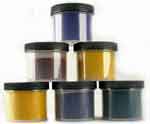Can I mix Retayne and citric acid in the same bath, so I can use both Cushing acid dye and "ordinary" Cushing dye?
Name: Brenda
—ADVERTISEMENTS—

Lanaset Dyes are among the very best dyes for hand-dyeing wool, silk, angora, mohair, and most nylons. You will also need: citric acid, sodium acetate, Glauber salt, Albegal SET, and Synthrapol.
Buy from
Paradise Fibers
Country or region: USA
Message: I'm using Cushing's dyes to dye wool roving. I have some of their acid dyes, and some of their "ordinary" type dyes. Can I mix Retayne and citric acid in the same bath, so I can use both types of dye? Thank you.
What are the "ordinary" type dyes that you have? W. Cushing makes acid dyes for wool and other protein fibers, and direct dyes for cotton and other cellulose fibers. However, they used to make an all-purpose dye, or union dye, that was a mixture of both the acid dyes and the direct dyes, which they have since discontinued because it makes more sense to choose the right type of dye for your fiber. So, are your "ordinary" Cushing dyes their current direct dyes for cotton, or are they some really old packages of their all-purpose dye? (Acid dyes, direct dyes, and all-purpose dyes stay good for a long time after purchase.)
While it might be possible to make a direct dye work better on wool by mixing it with a cationic dye fixative like Retayne, I don't like the idea at all. It's better to stick to acid dyes when you are dyeing wool. Some direct dyes will function as acid dyes, given the right dyeing conditions, but they're likely not to be quite as good as acid dyes for that purpose. You can be more sure that properly fixed acid dyes will perform predictably on wool, instead of crocking, bleeding, or fading. Dyeing is enough trouble that it's worth using good materials, so that you don't find out later that all of your effort was wasted on an inferior result.
Another important point is that Retayne is not entirely innocuous. (See my page on Retayne, at "Commercial Dye Fixatives".) Cationic dye fixatives like Retayne tend to reduce the lightfastness of dyes. This means that the dyed roving will be more likely to fade in the light, as compared to the same roving dyed with and acid dye and no Retayne. Sunlight is the worst for this, but even indoor lighting can cause fading after some time. (See "Lightfastness of Different Types of Dyes".)
Some people also don't like the idea of the tiny quantity of formaldehyde that is found in all of the cationic dye fixatives that are available for hand-dyers to buy in the US. This does not mean that it requires special safety precautions, though. You should always wear waterproof gloves and safety glasses when working with acid dyes or direct dyes, just as you should when working with Retayne.
(Please help support this web site. Thank you.)
(Please help support this web site. Thank you.)
Posted: Friday - May 04, 2012 at 09:11 AM
Follow this blog on twitter here.
Quick Links
- All About Dyes & Dyeing Top -
- Top of this blog -
- FAQ -
- The Dye Forum -
- How to Tie Dye - How to Batik -
- Books - Toys - Plants -
- Top of this blog -
- FAQ -
- The Dye Forum -
- How to Tie Dye - How to Batik -
- Books - Toys - Plants -
More in this category:
- -
Statistics
Total entries in this blog:
Total entries in this category:
Published On: Aug 29, 2012 02:49 PM
Total entries in this category:
Published On: Aug 29, 2012 02:49 PM